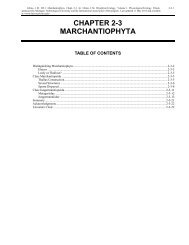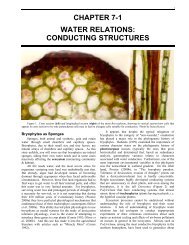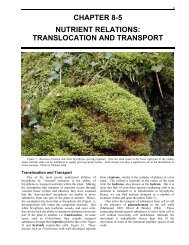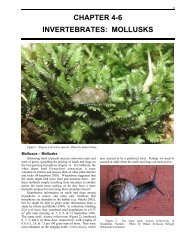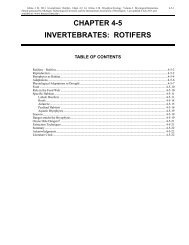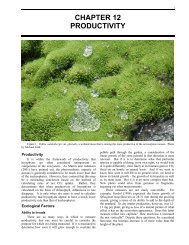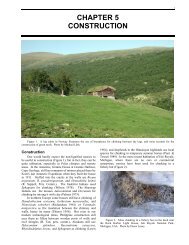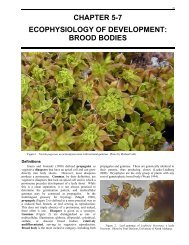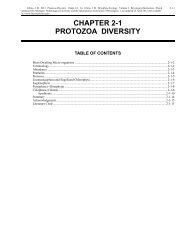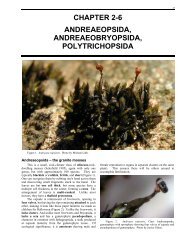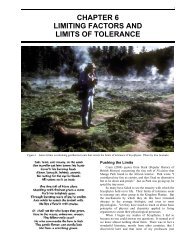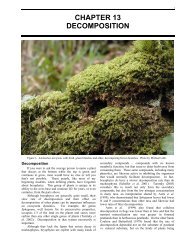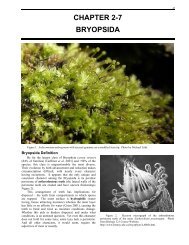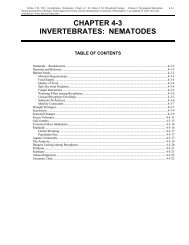chapter 8-3 nutrient relations: nitrogen - Bryophyte Ecology ...
chapter 8-3 nutrient relations: nitrogen - Bryophyte Ecology ...
chapter 8-3 nutrient relations: nitrogen - Bryophyte Ecology ...
Create successful ePaper yourself
Turn your PDF publications into a flip-book with our unique Google optimized e-Paper software.
20 Chapter 8-3: Nutrient Relations: Nitrogen<br />
Amino acids, leaking into the environment, could<br />
cause developmental anomalies leading to abnormal<br />
growth forms in bryophytes. Some amino acids, such as<br />
hydroxyproline, can cause desuppression in the<br />
development of underleaves in liverworts (Basile & Basile<br />
1980; Basile et al. 1988), causing them to look like normal<br />
leaves. In Atrichum, amino acids inhibited leafy shoot<br />
development (Burkholder 1959). This might be another<br />
example of the Gaia hypothesis (Lovelock, 1988), wherein<br />
the ecosystem behaves like a superorganism and species<br />
depend on other species for their biochemical needs during<br />
development.<br />
Nitrogen Fixation<br />
With 78% of our atmosphere being composed of<br />
<strong>nitrogen</strong> and only about 5% of biomass being <strong>nitrogen</strong>, one<br />
would expect this element to be no problem for living<br />
systems to obtain. But unlike phosphorus, it cannot<br />
normally be obtained from bedrock. And just as you and I<br />
can make no use of the free, gaseous <strong>nitrogen</strong> we breathe,<br />
most plants can't either. Instead, plants require their<br />
<strong>nitrogen</strong> fixed into ammonium (NH4 + ) or nitrate (NO3 - )<br />
salts (or converted to amino acids) before they can obtain<br />
and convert it to specific amino acids and proteins they<br />
need. Nitrogen fixation is the process of trapping<br />
atmospheric <strong>nitrogen</strong> and converting it to NH4 + and in<br />
some cases, converting it to NO3 - .<br />
Nitrogen fixation is a major source of usable <strong>nitrogen</strong>,<br />
particularly in bogs and fens. Like many tracheophytes,<br />
bryophytes can use N released by N fixation from<br />
associated bacteria and Cyanobacteria. The heterocysts<br />
(Figure 10) of Cyanobacteria make them a rich source of<br />
amino acids as a result of their <strong>nitrogen</strong>-fixing activity.<br />
That is, they are able to convert atmospheric N to a form<br />
usable by other living organisms.<br />
Figure 10. Anabaena (Cyanobacteria) showing heterocyst in<br />
middle lower part of picture. Photo by Janice Glime.<br />
In the process of <strong>nitrogen</strong> fixation in Cyanobacteria,<br />
the simple CH2O group from sugars, fixed by cells adjacent<br />
to the heterocyst, is moved into the heterocyst (Figure 11).<br />
Atmospheric <strong>nitrogen</strong> (N2) enters adjacent cells and is<br />
passed to the heterocyst. In the heterocyst <strong>nitrogen</strong><br />
reductase (enzyme that catalyzes addition of H + to N to<br />
form NH4 + ) catalyzes the transformation of N2 to the<br />
reduced NH4 + with H + obtained from the CH2O group.<br />
Figure 11. Nitrogen fixation in Cyanobacteria, with<br />
atmospheric <strong>nitrogen</strong> entering an adjacent cell and being<br />
transferred to the heterocyst, where it is converted to ammonium<br />
(NH4 + ). The ammonium is then moved to the adjacent cell where<br />
it is converted into organic compounds, typically amino acids.<br />
Diagram by Janice Glime.<br />
Many studies have shown that some bryophytes,<br />
especially peatland bryophytes, obtain N through N<br />
fixation processes of surface-dwelling Cyanobacteria as<br />
well as other bacteria (Cullimore & McCann 1972;<br />
Granhall & Selander 1973; Alexander et al. 1974; Basilier<br />
et al. 1978; Smith & Ashton 1981; Smith 1984; Nakatsubo<br />
& Ino 1986, 1987; Bentley 1987; Given 1987; Bergman et<br />
al. 1993; Madhusoodanan & Dominic 1996). In the<br />
Cyanobacteria, the most significant contributions come<br />
from taxa such as Nostoc (Figure 1), Anabaena, and<br />
Calothrix (Figure 12) that have special cells called<br />
heterocysts. These cells provide a "safe" environment for<br />
<strong>nitrogen</strong> fixation because they lack the oxygen-generating<br />
reactions of photosystem II. The enzyme <strong>nitrogen</strong><br />
reductase is unable to make the conversion in an aerobic<br />
environment, hence requiring a location where<br />
photosynthetic oxygen is not available. Since only the<br />
Cyanobacteria and some true bacteria are able to use the<br />
abundant atmospheric <strong>nitrogen</strong>, this conversion makes a<br />
significant contribution to usable <strong>nitrogen</strong> in the ecosystem.<br />
Figure 12. Upper: Algae on Campylopus at geothermal<br />
vent in New Zealand. Lower: Nostoc, a typical N-fixing<br />
Cyanobacterium that can be found associated with bryophytes.<br />
Photos by Janice Glime



